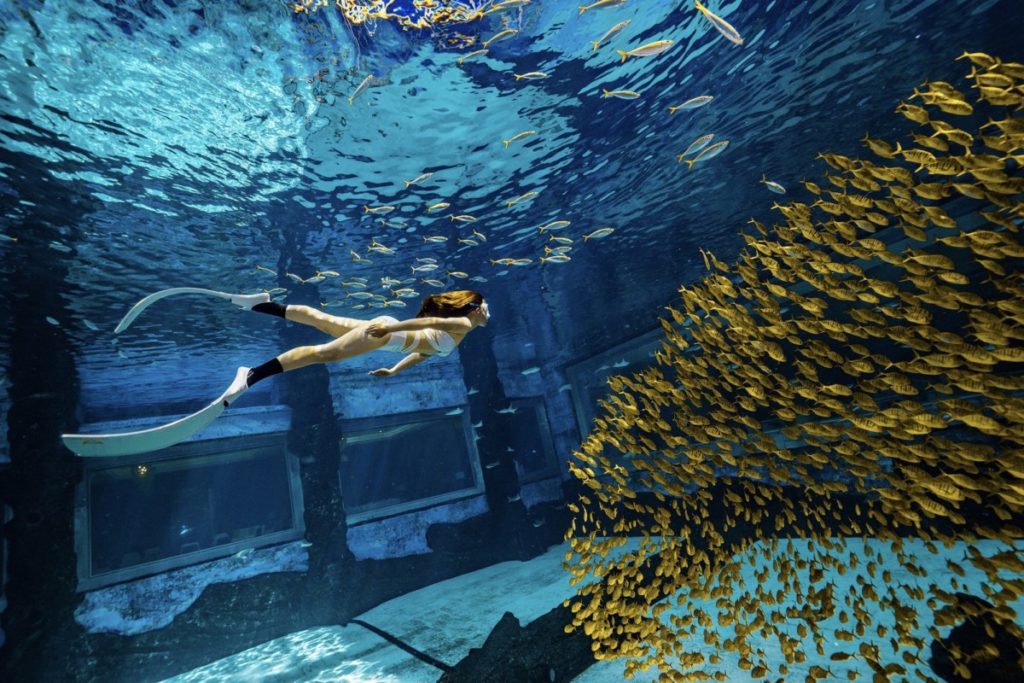
In class, we talked about the evolution of vision and also how vision varies between different species and kinds in nature. I have always been fascinated by the ocean since the very beginning. As a scuba diver, I have personally had many experiences in open water and known that the environment underwater can be extremely different from the environment on land. Colors would become dimmer and then disappear eventually, and my naked eyes just cannot focus to have a clear vision in water without my diving mask on. As a result, I decided to dig deeper into how and why certain visual traits are developed in the sea creatures to allow them to adapt and secure their survival underwater.
First and foremost, in aquatic environments, vision is in some ways less useful than on land due to the vast fundamental differences between the mediums creatures are surrounded by (Marshall 2017). Vision is necessarily the dominant sense on land for the air is clear and the earth atmosphere allows around 80% of light to come through (Marshall 2017). Living in well-lit environments, creatures on land naturally enhance their ability to capture light, thus having higher demands for their evolution of sights and visions. Taking advantage of the density of water, auditory and olfactory senses tend to be more advanced. For instance, a whale hunts down a giant squid in the dark by producing and analyzing a sound “image”; a salmon navigates up the already dissolved olfactory signature of its home river: both these tasks are achieved over a distance that vision would not allow (Marshall 2017). Also, color is less important to a night-active octopus than the textural, tactile, and chemosensory information provided by its eight legs (Marshall 2017).
Given the characteristics of aquatic environments, vision, or the lack of it, could now be well explained from one aspect: most of the living space in the ocean is dark for most of the time. According to Marshall’s experiment and investigation into the matter, sunlight does not penetrate below 1000 m in clearest ocean waters, at 200 m it is dim or indeed absent altogether in more turbid waters, and 80% of the ocean ecosystem lies below this latter depth (2017).
To further explore the role of light in aquatic environments, another significant limitation of vision would be caused by the rapid attenuation of light. In average ocean water, object contrast to background decreases exponentially over distance (Marshall 2017). As a result, most sea creatures go about their daily life in a “visual bubble”: an environment of only a few centimeters or at best a few meters, influencing the optical design of their eyes (Marshall 2017). Besides, there is no angle underwater and the resolving ability of fish eyes is ten times worse than that of human eyes (Marshall 2017); there is simply no need for a very detailed and sharp resolution in a marine environment where everything tends to be very close-up and smaller. To provide further explanation, fish that do want to communicate as far as possible, such as the pair-bonded butterflyfish or territorial triggerfish on the reef, often chose the highest contrast combination of bold black and white to maintain contact as far as possible (Marshall 2017).
As we could potentially tell, the design of the visual systems of sea animals is very diverse due to the fact that the amount of light coming through varies so dramatically in different regions, areas, and depth underwater. Many more questions are waiting to be addressed at a certain point in time. For many reasons, including the mysteries underwater, it is time that we returned to the ocean to where everything started and see what the ocean really teaches us about.
References:
Marshall J. Vision and lack of vision in the ocean. Current biology: CB. 2017;27(11): R494–R502.
Siebeck UE, Wallis GM, Litherland L. Colour vision in coral reef fish. The journal of experimental biology. 2008 [accessed 2020 Sep 21];211(Pt 3):354–360.
“Coral hind at Shelenyat Reef, Red Sea, Egypt #SCUBA #UNDERWATER #PICTURES” by Derek Keats is licensed with CC BY 2.0. To view a copy of this license, visit https://creativecommons.org/licenses/by/2.0/
“Sohal Surgeonfish, Acanthurus sohal at Fanous East Reef, Red Sea, Egypt #SCUBA #UNDERWATER #PICTURES” by Derek Keats is licensed with CC BY 2.0. To view a copy of this license, visit https://creativecommons.org/licenses/by/2.0/